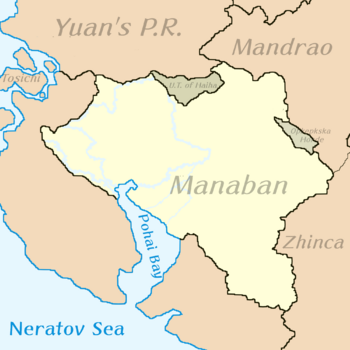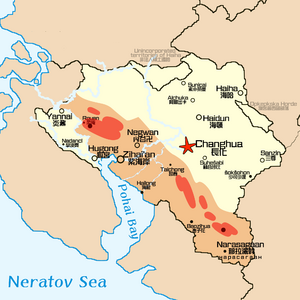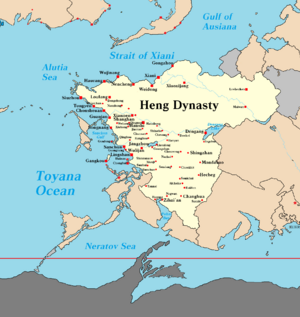Manaban: Difference between revisions
Manabanman (talk | contribs) |
Manabanman (talk | contribs) |
||
| Line 97: | Line 97: | ||
| Festival of Brass || Amwana || singing, music by default. || June 21st || | | Festival of Brass || Amwana || singing, music by default. || June 21st || | ||
|- | |- | ||
| [ | | [https://iiwiki.us/mediawiki/index.php?title=Manaban&action=edit§ion=9 Quirky Ghost Festival] || Yanjing || Death, mortality and immortality, underworld, among others. || August 12th || | ||
|} | |} | ||
Revision as of 05:51, 14 December 2021
Nationalist Republic of Manaban ᠮ᠊ᠠᠨ᠊ᠠᠪ᠊ᠠᠨᠨ᠋ ᡬ᠊᠊ᡠᠪ᠊ᠴ᠊ᡳ᠋ ᡳ᠊᠊ᡵ᠊ᡬ᠊᠊ᡝ᠊ᠨ᠋ ᡬ᠊ᡠ᠊᠊ᡵ᠊᠊ᡠ᠊ᠨ᠋/
Gubcin Irgen Manaban Gurun 滿阿半國民共和國 ꡂꡧꡡꡏꡞꡋ ꡂꡡꡃꡜꡠꡂꡧꡡ / Mǎnābàn guómín gònghéguó Үндэсний Бүгд Найрамдах Улс / Ündesniibügd Nairamdakhuls | |
|---|---|
|
Flag | |
| Motto: "Mini Mafa Gurun" | |
| Anthem: Yellow and purple fields | |
 | |
| Capital | Changhua |
| Largest city | Zihai'an |
| Official languages | Mannese, Southwestern Yauneze, Mingonian, Belogorskovi |
| Ethnic groups | Mannese, Yuaneze,Mingonian, Beleroskovi |
| Government | Assymetrical federalist parliamentary government |
• Prime Minister | Zi Sirin Gioro |
| Currency | (Mannese Yen) (滿元 (MBY)) |
| Calling code | +686 |
| Internet TLD | .mb |
Officially the National Republic of Manaban , is a country in Southwestern Ausiana, bordering north to Yuan and Mandrao, The unincorporated territories of Haiha and Mandrao. To the East with Mandrao, The Opkepkska Horde; Zhinca, and to the south with the Neratov Sea and Pohai Bay. Encompassing almost a million square kilometers (exactly 900,000 sq km) it is considered a fair-sized country inside of its native continent, ruled by the Ausiana Identity Coalition (澳西阿那身份聯盟) leadered by Prime Minister Zi Sirin Gioro. It has a population of 37,231,000.
Prehistory
There is registry about a newly discovered culture now baptized as the Guihai river civilization which dates to at least 45,000 years. Truly one of the most ancient traces of human organization in all of Manaban's territories. Though these are only remainders of it, like small, previously unidentified huts not compatible with any of the region's cultures and other items like clay pots and wooden pipes.
Manaban also counts with two known tar pits within its national limits, the Rouanese tar pit and the Nanshao tar pit, where most of Manaban's paleontological discoveries have been made. There have been at least 8 complete skeleton discoveries and 32 partial bone discoveries to this day.
Prehistoric Geography
Mannese lands used to be different to today's landscapes are. Approximately 45 million years ago, Manaban was mostly formed by a chain of islands which paleontologists have named the Sohontu Archipelago. The place that resembles these islands the most in current times is the westernmost wetlands of the Hugong river delta.
Prehistoric Fauna
Some of the most recently discovered animals in the Sontohu Archipelago are the Sabuharaptor, a mid-sized opportunist scavenger from the late periods. Its name literally means Saw thief.
Mudurisaurus, which is a large carnivorous draconic quadruped reptilian that dwelled in the warm tropical forest glades. Its fossils might be the reason why Mannese people are obsessed with dragons. So far, only 4 specimens have been registered.
Australornis Ausianensis meaning southern Ausianan bird is the only species of its kind currently. It's a piscivore migratory bird with a wingspan of 10 meters.
And Akjanodon; literally thundertusk is the male characteristic for which they've been known. It's speculated these gigantic tusks were used to fend the carnivorous competition. One of the most competent animals of its era which was a marsupial rather than a reptile.
All of these animals are from different periods of time and islands.
Modern History
Heng Dynasy
The Heng Dynasty (short for 永恒朝 Yǒnghéng cháo, Eternal dynasty) was the last imperial power to rule over the encompassing territory of the Yuan People's Republic, Mandrao and Manaban. It was founded by the Mannese conqueror Geleku Khan after the overthrow of the Lim dynasty.
Culturally originated in Manaban, the firstly recognized as a Khanate annexed southern parts of Yuan and the entirety of Mandrao. Then colonized the rest of Yuan.
After 278 years the Heng dynasty came to an end due to technological stagnation, isolationism and the Yellow flag rebellion.
The Yellow Flag Rebellion
In February 7th of 1900 the rebellion began in southern Xiannen, as the local government administrative offices were burnt down. Soon enough, the feeling spread rapidly throughout the Purple and Xihazi rivers.
The Mannese royal family members aristocracy and other people of the same ethnicity fled to their ancestral homeland in the south. Even though the last emperor of the Heng Dynasty, Pan Guanting, was assassinated in 1908 during the Yuan Revolution by leftwing extremist groups. The house of Sirin Gioro was kept intact together with the other Mannese original founding clans.
Etymology
The term comes from the colloquial term to rebel against the yellow flag 反抗黃旗 (Fǎnkàng huáng qí), the yellow traditionally representing the Mannese ethnicity hence the main color of the national flag.
Flag and banner as terms of leadership and dynastic rule in Southwestern Ausiana.
Causes
Mismanagement from the imperial government, misrepresentation and heavy isolationism in an expansionist moment of history were the key factors to major dissidence and eventual uprisings.
Manaban Independence
Following the fall of the Heng Dynasty and official establishment of the Communist Party of Yuan, the Mannese and Mandraonian Dengangian and Pangchunese revolutions burst in the south, given the fact that all these places were forced into racial segregation.
In 1910 after the mass immigrations of minorities to the southwest, the Haidun conference took place on the namesake city where the borders with Yuan and her southwestern neighbors were finally drawn in the map. Mannese independence is declared and recognized officially by March 1 of 1912, though at the beginning it wasn't as patriotically accepted as it is now. the Yellow flag rebellion marked an obscure chapter in the history for Mannese, putting an end to a global powerhouse empire led by them and displacing their people, being forced to move thousands of kilometers away to find refuge made it hard to keep a high morale. A torn economy and lack of organization almost made Manaban collapse during her first years of existence. Zhang Luoming was the hero and a true caudillo that brought cohesion to the country by campaigning against local dissidents and general thieves on the roads between the most important cities which allowed a proper communication, and development for the first time.
Religion in Manaban
Manaban is a predominantly Buddhist nation, Hinayana Buddhism, as most Southwestern Ausianan countries with her own regional variant. Mannese Hinayana Buddhism, also known as 祖教 (Zǔ jiào) or The ancestors' teachings due to its heavy influence in ancestor worshipping is a polytheistic, somehow animistic, syncretist religion, result of the exposure between different shamanistic old practices and folk religions with minimal regulation thus allowing many lesser gods and legends to be added to it, keeping it rich and consistent.
Mannese Zǔ jiào has a wide pantheon that includes major deities, universal to all Hinayana Buddhist countries like Chaotiannu and Sun Gohong but also some exclusive to regions of Manaban, as listed below.
| Festivity name | Deity celebrated | Deity attribution | Date | |
|---|---|---|---|---|
| Fertility Festival | Amwana | Femininity, animal breeding, maternity, amont others. | March 20th | |
| Festival of (Mannese) language | Gisunbai | Language, communication. | February 22nd | |
| Summer Solstice Festival | Example | The sun, heat, fire, among others. | April 12th | |
| Festival of Brass | Amwana | singing, music by default. | June 21st | |
| Quirky Ghost Festival | Yanjing | Death, mortality and immortality, underworld, among others. | August 12th |
Culture
Quirky Ghost Festival
The Quirky Ghost Festival (古怪鬼节 Gǔguài guǐ jié) is a syncretized tradition where several Mannese ethnicities gather together to remember their ancestors and honor them.
At dusk, blue and purple candles and paper lanterns are lit due to the fact that, in Manaban this combination simbolizes the past and the non-living.
The event occurs on the first week of the tenth month of the Ausianan calendar. Though the whole week is celebrated, only the only day off given by employers is friday.
People tend to prepare, eat and sell meals on the streets, setting up pasar malams (or Yeshi 夜市) to enjoy several traditional yauneze and mannese dishes.
Olonkho
Olonkho is an ethnic Mannese part of the oral tradition of Guguai guijie, followed right after the dinner in pasar malams in which important events of the current years are related as a song by a narrator. More elaborated Olonkho include actors with dialogues and an entire plot for a well condensed play. Olonkho may last somewhere between 2 to 6 hours and due to the fact of being hours long it makes Olonkho use several breaks and it is considered an honor to participate in one, there is a personnel of yearly volunteers that fill in the most important characters; secondary characters are selected through a raffle.
It is said to be originated in central Ausianan steppes' oral song tales of the same kind, passed down by merchants and thus explaining why it always comes after the market-like dinner. It is known by the same name and most of the details are kept the same.
Soidu
Literally Omen shift is yet another Mannese ethnical practice adopted nationwide. It consists in a superstitious curfew, for fear of encountering a ghost without carrying an offering for it.
Though it's never been registered to be mandated by the state, many people leave the streets after 11:00 PM during these dates unless a yaya hacin is worn. Yaya hacin comes from Mannese and it means any kind of-, whatever kind of-. for these dates, it is an amulet that is needed in order to protect from ghostly presences and being haunted by them.
Offerings
Offers to the diseased are set in public places including things such as food, cigars, incense, and music through the previously mentioned Olonkho and the more recently incorporated Getai. It is important to mention that leftovers, badly played Olonkho and Getais are frown upon to be received as an offering.
People is used to gift away these kind of items because unlike money and physical objects, food and songs can be compared more to events with an essence that can be consumed by spiritual beings, though some people in the southern regions do burn hell money for their ancestors to stay longer, as a bribe to the underworld gods.




